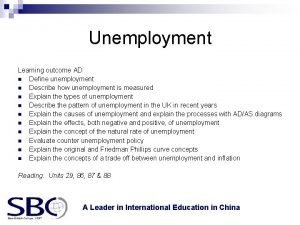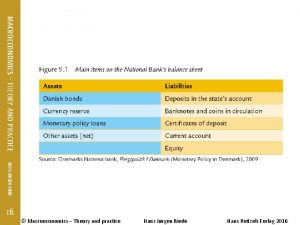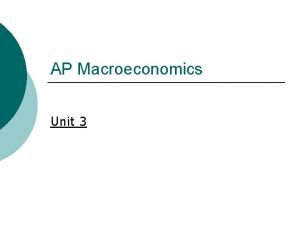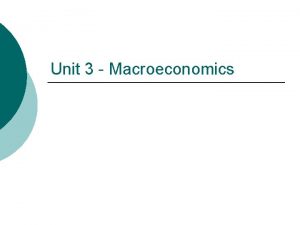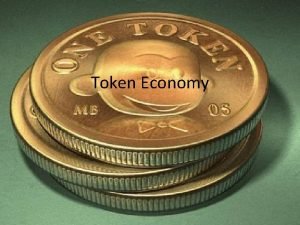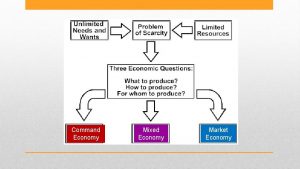Macroeconomics Macroeconomics is the study of the economy













































- Slides: 45

Macroeconomics • Macroeconomics is the study of the economy as a whole. u Its goal is to explain the economic changes that affect many households, firms, and markets at once.

The Economy’s Income and Expenditure When judging whether the economy is doing well or poorly, it is natural to look at the total income that everyone in the economy is earning.

The Economy’s Income and Expenditure • For an economy as a whole, income must equal expenditure because: u u Every transaction has a buyer and a seller. Every rupee of spending by some buyer is a rupee of income for some seller.

Gross Domestic Product • • Gross domestic product (GDP) is a measure of the income and expenditures of an economy. It is the total market value of all final goods and services produced within a country in a given period of time.

The Measurement of GDP is the market value of all final goods and services produced within a country in a given period of time.

Other Measures of Income • • • Gross National Product (GNP) Net National Product (NNP) National Income Personal Income Disposable Personal Income

Gross National Product • • Gross national product (GNP) is the total income earned by a nation’s permanent residents (called nationals). It differs from GDP by including income that our citizens earn abroad and excluding income that foreigners earn here.

Net National Product (NNP) • • Net National Product (NNP) is the total income of the nation’s residents (GNP) minus losses from depreciation. Depreciation is the wear and tear on the economy’s stock of equipment and structures.

National Income • • National Income is the total income earned by a nation’s residents in the production of goods and services. It differs from NNP by excluding indirect business taxes (such as sales taxes) and including business subsidies.

Personal Income • • • Personal income is the income that households and noncorporate businesses receive. Unlike national income, it excludes retained earnings, which is income that corporations have earned but have not paid out to their owners. In addition, it includes household’s interest income and government transfers.

Personal Disposable Income u u u Personal disposable income represents the income that households are free to spend or save. It excludes the components of national income that do not accrue directly to households. It also includes a few items that are not part of national income but nonetheless influence the amount of income that households can spend.

• PI = NI – corporate profits – social security and other contributions –net interest + Dividends + government transfers + personal interest income.

The Components of GDP (Y ) is the sum of the following: u u Consumption (C) Investment (I) Government Purchases (G) Net Exports (NX) Y = C + I + G + NX

The Components of GDP • Consumption (C): u • The spending by households on goods and services, with the exception of purchases of new housing. Investment (I): u The spending on capital equipment, inventories, and structures, including new housing.

The Components of GDP • Government Purchases (G): u u • The spending on goods and services by local, state, and federal governments. Does not include transfer payments because they are not made in exchange for currently produced goods or services. Net Exports (NX): u Exports minus imports.

Some Limitations of GDP or GNP as measures of growth u u Ignores income distribution Ignores environmental degradation Does not include activities that do not go through the formal markets sectors Does not include “illegal” activities like drug trafficking, prostitution, moonlighting

Real versus Nominal GDP • • Nominal GDP values the production of goods and services at current prices. Real GDP values the production of goods and services at constant prices.

Real versus Nominal GDP An accurate view of the economy requires adjusting nominal to real GDP by using the GDP deflator.

GDP Deflator • • The GDP deflator measures the current level of prices relative to the level of prices in the base year. It tells us the rise in nominal GDP that is attributable to a rise in prices rather than a rise in the quantities produced.

GDP Deflator The GDP deflator is calculated as follows:

Converting Nominal GDP to Real GDP Nominal GDP is converted to real GDP as follows:

Real and Nominal GDP

Real and Nominal GDP

Real and Nominal GDP

Real and Nominal GDP

• METHOD OF COMPUTING NI

Output Method • This method measures the output of the country and is also called as the inventory method. It involves the assessment, through census, of the gross value of production of goods and services produced in different economic sectors by all the productive enterprises in the economy. The symbolic expression for this method may be given as follows:

• • • Y = (Pr-D) + (S-T) + (X –M) + (R-P) Where Y = national income Pr = domestic output of all production sectors D = depreciation allowance S = subsidies

• • • T = indirect taxes X = exports M = imports R = receipt from abroad P = payment made abroad

Census of Income Method • This method is also known as factor cost method. Thus, the national income of a country at factor cost is equivalent to the sum total of disbursements of their factors’ income which can be symbolically expressed as: • Y = (w + r + i + ð) + (X –M) + (R-P)

• • • Where Y = national income w = wages r = rent i = interest ð = profits X = exports M = imports R = receipt from abroad P = payment made abroad

The Expenditure or Outlay Method • National income on the expenditure side is equal to the value of consumption plus investment. In this method, we have to estimate private and pubic expenditure on consumer goods and services, add the value of investment in fixed capital and stocks, with due consideration for net positive or negative inventories, and add the value of exports and deduct the value of imports.

• This method is not as popular as the previous ones. • To express it in symbolic terms, • Y = (C+I+G) + (X –M) + (R-P)

DIFFICULTIES IN THE MEASUREMENT OF NATIONAL INCOME • There are certain difficulties in the measurement of National Income. They are given below: , • 1. The National Income must be calculated in monetary terms. There are certain nonmonetary transactions which are not included in the value of product. For example the unpaid personal services of a housewife cannot be included in the national product.

2. The Government services such as justice. administration and defence should he treated as equivalent to any other capital formation. • 3. The treatment of profits of foreign firms as income of the parent country is another difficulty in measurement, because the foreign firms production is taking place in India while the profits of the firm is not considered in the income calculation of the country

• 4. In underdeveloped countries like India, the major part of the output does not come to the market due to non monitised transaction. This results in the underestimation of the National Income. • 5. Due to illiteracy regular accounts are not kept by the producers. This also makes the national income calculation more difficult.

• 6. The agriculture and industrial sectors are unorganized and scattered in India. • 7. Finally the lack of statistical data and unreliability of statistics is the major difficulties in measuring the National Income. • 8. A Greatest difficulty in calculating the national income is of double counting which arises from the failure, to distinguish properly, between a final and intermediate product.

• 9. Income earned through illegal activities such as gambling or illicit extraction of wine etc is not included in national income. Such goods and services do have value and meet the needs of consumers. But by leaving them out, national income works out to less than actual.

• 10. There arises difficulty of including transfer payments in the national income. • Individuals get pension, unemployment allowance and interest on public loan's but whether these should be included on the national income in a difficult problem.

• 11. Another difficulty in calculating national income is that of price changes which fail to keep stable the measuring rod of money for national income. When the price level in the country rises the national income also shows an increase even though production might have fallen.

SIGNIFICANCE OR IMPORTANCE OF NATIONAL INCOME ESTIMATES • The following are the main uses of national income analysis: • 1 The national income estimate reveals the overall production performance of the economy. It records the level of production in each year. This enables to compare the real growth of the economy over the years. • 2. The percapita income measures the average standard of living of the people. It is used to compare standards of living in different countries.

• 3. National income data are used to measure economic welfare of the community. Other things being equal, economic welfare is greater if rational income is higher • and vice versa. • 4. The study of national income statistics is useful in diagnosing the economic ills of a country and suggesting remedies. • 5. The national income figures are useful in assessing the pace of economic development of a country

• 6. The national income figures are used to assess the savings and investment potential of the community. The rate of saving and investment depend on national income. • 7. The comparison of rational income over the years enables to know the nature of the economy. This is important when the government of a country launches planning for economic development. In factor planning is possible without national income estimates. • 8. National income estimates show the contribution made by different sectors of the economy such as agriculture, industry, trade and commerce, service etc. On the basis of national income figures.

• National income estimates will tell us how far different categories of income such as rent, wages, interest, and profits are contributing to national income. • 10. The formulation of panning for different sectors of the economy is based on the national income figures. National income estimates are very useful in formulating plans for the development of agriculture, industry, infrastructure etc.

• 11. We can evaluate the achievements of the development targets laid down in the plus from the changes in national income and various components. • 12. National income data are useful forecasting future economic events. • 13. National income statistics can be used to determine how an international financial burden should be apportioned between different countries. • 14. In war time the study of the components of national income is of great importance because they show the maximum production possibilities of the country.
 Chapter 31 open economy macroeconomics
Chapter 31 open economy macroeconomics Athenian economy vs sparta economy
Athenian economy vs sparta economy Marty lobdell study less study smart
Marty lobdell study less study smart What is case series
What is case series Phytogeographical regions of india map
Phytogeographical regions of india map Retrospective cohort study
Retrospective cohort study Differentiate between time study and motion study
Differentiate between time study and motion study Critical examination in method study
Critical examination in method study Time and motion study example ppt
Time and motion study example ppt New classical and new keynesian macroeconomics
New classical and new keynesian macroeconomics Ap macro graphs
Ap macro graphs Components of macroeconomics
Components of macroeconomics Open market operations
Open market operations N
N Recessionary gap
Recessionary gap Whats included in gdp
Whats included in gdp Crowding out effect macroeconomics
Crowding out effect macroeconomics Macroeconomics by mankiw
Macroeconomics by mankiw Nicepp
Nicepp Macroeconomics chapter 7
Macroeconomics chapter 7 Macroeconomics chapter 23
Macroeconomics chapter 23 Significance of microeconomics
Significance of microeconomics New classical and new keynesian macroeconomics
New classical and new keynesian macroeconomics 2012 ap macroeconomics free response answers
2012 ap macroeconomics free response answers Voluntary unemployment
Voluntary unemployment New classical macroeconomics
New classical macroeconomics Macroeconomics theory and practice
Macroeconomics theory and practice Transfer payments
Transfer payments Macroeconomics
Macroeconomics Tourism macroeconomics
Tourism macroeconomics Microeconomics michael parkin 13th edition
Microeconomics michael parkin 13th edition Macroeconomics
Macroeconomics Ap macroeconomics-percentage for a 5
Ap macroeconomics-percentage for a 5 Lesson 2 activity 45 macroeconomics
Lesson 2 activity 45 macroeconomics Micro economics example
Micro economics example Monetarist vs classical economics
Monetarist vs classical economics Macroeconomics
Macroeconomics Macroeconomics
Macroeconomics Founder of macroeconomics
Founder of macroeconomics Ap macro unit 3
Ap macro unit 3 Macroeconomics
Macroeconomics Macroeconomics
Macroeconomics Crowding out effect macroeconomics
Crowding out effect macroeconomics Macroeconomics
Macroeconomics Fiscal policy in macroeconomics
Fiscal policy in macroeconomics Macroeconomics
Macroeconomics
























